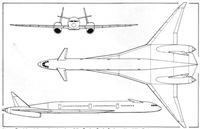Фотографии
-
Rolls-Royce is one of three engine manufacturers to express interest in the Sonic Cruiser programme. The Trent 800 family (one of which is seen here), currently in production for the Boeing 777, generate thrust levels in the order of 90,000lb - ideal for the present Sonic Cruiser estimates.
Самолёты на фотографии: Boeing Boeing 777 - США - 1994
-
This model of the Sonic Cruiser, in a preliminary design configuration, was exhibited at the 2001 Paris Air Show.
Самолёты на фотографии: Boeing Sonic cruiser - США - 2002
-
This wind tunnel model of the Sonic Cruiser has been tested at Mach 1.08. Preliminary data indicates that the aircraft will be able to reach 10,000ft in 2 1/2 minutes and 41,000ft in around 16 minutes.
Самолёты на фотографии: Boeing Sonic cruiser - США - 2002
-
Sonic Cruiser
Самолёты на фотографии: Boeing Sonic cruiser - США - 2002
-
A number of key potential customer airlines are being invited to form a consultative working group to finalise specific characteristics and operational requirements for the Sonic Cruiser, an approach which proved very successful in the 777 development programme. This computer-generated image shows the aircraft resplendent in Singapore Airlines colours.
Самолёты на фотографии: Boeing Sonic cruiser - США - 2002
-
Note the dihedral on the canard foreplane and the inward-canted fins. The fin geometry was one design aspect which led to speculation that the Sonic Cruiser has a classified military origin, the suggestion being that they were inclined in order to reduce the radar cross-section. The deeply-buried engines helped fuel the rumours - which were denied by senior Boeing executives.
Самолёты на фотографии: Boeing Sonic cruiser - США - 2002
-
Note the Sonic Cruiser's highly-swept wing tips and 'beaver tail' between the engine nacelles, which are clearly apparent in this view.
Самолёты на фотографии: Boeing Sonic cruiser - США - 2002
-
"Соник Крузер" - трансзвуковой козырь "Боинга"
With the Sonic Cruiser, Boeing has 'broken the mould' of traditional airliner design. Other, albeit smaller, canard configurations, such as the Beech Starship and Piaggio Avanti have not sold as well as many of their conventional contemporaries, so it will be interesting to see if this revolutionary design will be accepted by farepaying passengers.Самолёты на фотографии: Boeing Sonic cruiser - США - 2002
-
Provisional three-view drawing of the Boeing Sonic Cruiser
Самолёты на фотографии: Boeing Sonic cruiser - США - 2002
Статьи
- -
- Airscene
- Talkback
- ??? - QinetiQ. Dynamic in Name and Nature /Industry/
- A.Dawes - Nimrod MRA.4 /Military/
- A.Dawes - Tupolev's Bear /Military/ (2)
- B.Perrett - Sonic Cruiser /Commercial/
- B.Walters - Taking the road to recovery /Commercial/
- D.Marshall - SBAC. The way ahead /Industry/
- I.Goold - A Tale of Two Industries /Commercial/
- J.Cook - Aviator or Flight Manager? /Technology/
- J.Lake - Eurocopter EC 135 /Rotary wing/
- J.Lake - Westland Super Lynx /Military/
- R.Gardner - Aerospace in the UK /Industry/
- R.Hewson - Airbus A380. Europe's giant giant-killer /Commercial/
- R.Hewson - JSF UK. More than just aircraft /Military/








